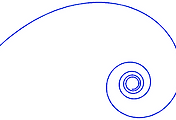수학(mathematics)에서, 삼각 치환(Trigonometric substitution)은 다른 표현에 대해 삼각 함수의 치환(substitution)입니다. 우리는 제곱근 표현(radical expression)을 포함하는 특정 적분(integral)을 단순화하기 위해 삼각 항등식(trigonometric identities)을 사용할 수 있습니다:

Examples
Integrals containing \(a^2-x^2\)
다음 적분에서,
\(\quad\displaystyle \int\frac{dx}{\sqrt{a^2-x^2}},\)
우리는 다음을 사용할 수 있을 것입니다:
\(\quad\displaystyle x=a\sin \theta,\quad dx=a\cos\theta\, d\theta, \quad \theta=\arcsin\left(\frac{x}{a}\right).\)
그런-다음,
\(\quad \begin{align}
\int\frac{dx}{\sqrt{a^2-x^2}} &= \int\frac{a\cos\theta \,d\theta}{\sqrt{a^2-a^2\sin^2 \theta}} \\
&= \int\frac{a\cos\theta\,d\theta}{\sqrt{a^2(1 - \sin^2 \theta )}} \\
&= \int\frac{a\cos\theta\,d\theta}{\sqrt{a^2\cos^2\theta}} \\
&= \int d\theta \\
&= \theta + C \\
&= \arcsin \left(\frac{x}{a}\right)+C.
\end{align}\)
위의 단계는 a > 0 및 cos(θ) > 0임을 요구합니다; 우리는 a를 \(a^2\)의 양의 제곱근으로 선택할 수 있고, 우리는 아크사인(arcsin) 함수를 사용함으로써 θ에 제한 −π/2 < θ < π/2을 적용합니다.
정적분에 대해, 우리는 적분의 경계가 어떻게 변하는지 알아내야 합니다. 예를 들어, x가 0에서 a/2로 갈 때, sin θ는 0에서 1/2로 가므로, θ는 0에서 π/6로 갑니다. 그런-다음, 다음입니다:
\(\quad\displaystyle \int_0^{a/2}\frac{dx}{\sqrt{a^2-x^2}}=\int_0^{\pi/6} d\theta = \frac{\pi}{6}.\)
약간의 주의는 경계를 선택할 때 필요됩니다. 위의 적분은 −π/2 < θ < π/2임을 요구하므로, θ가 0에서 π/6까지 가는 것이 유일한 선택입니다. 이 제한을 무시하면, 우리는 θ가 π에서 5π/6로 가는 것을 선택할 수 있으며, 이것은 실제 값의 음수의 결과를 초래합니다.
Integrals containing \(a^2+x^2\)
다음 적분에서
\(\quad\displaystyle \int\frac{dx}{a^2+x^2}\)
우리는 다음을 쓸 수 있을 것입니다:
\(\quad\displaystyle x=a\tan\theta,\quad dx=a\sec^2\theta\, d\theta, \quad \theta=\arctan\frac{x}{a},\)
그런-다음 적분은 다음이 됩니다:
\(\quad \begin{align}
\int\frac{dx}{a^2+x^2} &= \int\frac{a\sec^2\theta\, d\theta}{a^2 + a^2\tan^2\theta} \\
&= \int\frac{a\sec^2\theta\, d\theta}{a^2(1+\tan^2\theta)} \\
&= \int\frac{a\sec^2\theta\, d\theta}{a^2\sec^2\theta} \\
&= \int\frac{d\theta}{a} \\
&= \frac{\theta}{a}+C \\
&= \frac{1}{a} \arctan \frac{x}{a} + C,
\end{align}\)
여기서 a ≠ 0입니다.
Integrals containing \(x^2-a^2\)
다음과 같은 적분
\(\quad\displaystyle \int\frac{dx}{x^2 - a^2}\)
은 삼각 치환이라기 보다는 부분 분수(partial fractions)에 의해 역시 평가될 수 있습니다. 어쨌든, 적분
\(\quad\displaystyle \int\sqrt{x^2 - a^2}\, dx\)
은 부분 분수로 적분할 수 없습니다. 이 경우에서, 적절한 치환은 다음입니다:
\(\quad\displaystyle x = a \sec\theta,\quad dx = a \sec\theta\tan\theta\, d\theta, \quad \theta = \text{arcsec}\frac{x}{a}.\)
그런-다음, 다음입니다:
\(\quad \begin{align}
\int\sqrt{x^2 - a^2}\, dx &= \int\sqrt{a^2 \sec^2\theta - a^2} \cdot a \sec\theta\tan\theta\, d\theta \\
&= \int\sqrt{a^2 (\sec^2\theta - 1)} \cdot a \sec\theta\tan\theta\, d\theta \\
&= \int\sqrt{a^2 \tan^2\theta} \cdot a \sec\theta\tan\theta\, d\theta \\
&= \int a^2 \sec\theta\tan^2\theta\, d\theta \\
&= a^2 \int (\sec\theta)(\sec^2\theta - 1)\, d\theta \\
&= a^2 \int (\sec^3\theta - \sec\theta)\, d\theta.
\end{align}\)
우리는 그런-다음 시컨트 세제곱의 적분(integral of secant cubed)에 대해 공식을 사용하여 이것을 풀 수 있습니다.
Substitutions that eliminate trigonometric functions
치환은 삼각 함수를 제거하기 위해 사용될 수 있습니다. 특히, 탄젠트 반-각 치환(Tangent half-angle substitution)을 참조하십시오.
예를 들어,
\(\begin{align}
\int f(\sin(x), \cos(x))\, dx &=\int\frac1{\pm\sqrt{1-u^2}} f\left(u,\pm\sqrt{1-u^2}\right)\, du && u=\sin (x) \\
\int f(\sin(x), \cos(x))\, dx &=\int\frac{1}{\mp\sqrt{1-u^2}} f\left(\pm\sqrt{1-u^2},u\right)\, du && u=\cos (x) \\
\int f(\sin(x), \cos(x))\, dx &=\int\frac2{1+u^2} f \left(\frac{2u}{1+u^2},\frac{1-u^2}{1+u^2}\right)\, du && u=\tan\left (\tfrac{x}{2} \right ) \\
\int\frac{\cos x}{(1+\cos x)^3}\, dx &= \int\frac2{1+u^2}\frac{\frac{1-u^2}{1+u^2}}{\left(1+\frac{1-u^2}{1+u^2}\right)^3}\, du = \int (1-u^2)(1+u^2)\, du
\end{align}\)
Hyperbolic substitution
쌍곡선 함수(hyperbolic function)의 치환은 적분을 단순화하기 위해 역시 사용될 수 있습니다.
적분 \(\displaystyle \int \frac{1}{\sqrt{a^2+x^2}}\, dx\)에서, 치환 \(x=a\sinh{u}\), \(dx=a\cosh u\, du\)을 만듭니다.
그런-다음, 항등식 \(\cosh^2 (x) - \sinh^2 (x) = 1\) 및 \(\sinh^{-1}{x} = \ln(x + \sqrt{x^2 + 1})\)을 사용하여,
\(\begin{align}
\int \frac{1}{\sqrt{a^2+x^2}}\, dx &= \int \frac{a\cosh u}{\sqrt{a^2+a^2\sinh^2 u}}\, du\\
&=\int \frac{a\cosh{u}}{a\sqrt{1+\sinh^2{u}}}\, du\\
&=\int \frac{a\cosh{u}}{a\cosh u}\, du\\
&=u+C\\
&=\sinh^{-1}{\frac{x}{a}}+C\\
&=\ln\left(\sqrt{\frac{x^2}{a^2} + 1} + \frac{x}{a}\right) + C\\
&=\ln\left(\frac{\sqrt{x^2+a^2} + x}{a}\right) + C
\end{align}\)
See also
References
- Stewart, James (2008). Calculus: Early Transcendentals (6th ed.). Brooks/Cole. ISBN 0-495-01166-5.
- Thomas, George B.; Weir, Maurice D.; Hass, Joel (2010). Thomas' Calculus: Early Transcendentals (12th ed.). Addison-Wesley. ISBN 0-321-58876-2.
- Boyadzhiev, Khristo N. "Hyperbolic Substitutions for Integrals" (PDF). Retrieved 4 March 2013.


